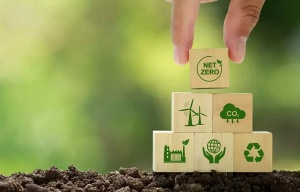Vietnam’s construction sector welcomes a greener vision
 |
| Assoc. Prof. Dr. Vu Ngoc Anh, Director, Department of Science, Technology and Environment Ministry of Construction |
Vietnam has committed to 2030 a reduction in GHG emissions from the sectors of energy, agriculture, forestry, land use, waste, and industrial processes, according to the Nationally Determined Contribution (NDC) report from 2022. Under a business-as-usual scenario, the nation’s contribution to reducing emissions increased from 9 per cent (2020 NDC) to 15.8 per cent (equivalent to 146 million tonnes of CO2) without international support.
With assistance, the contribution rose from 27 per cent to 43.5 per cent, equivalent to approximately 403.7 million tonnes of CO2.
In 2022, the government issued regulations on the mitigation of GHG emissions and the protection of the ozone layer. Assigning 13 per cent of the overall emission reduction, the construction sector is obligated to decrease 74.3 million tonnes of CO2 equivalent by 2030 due to energy consumption and industrial processes associated with the manufacturing of construction materials and structures. Nevertheless, the construction industry’s role in reducing GHGs will rise, per the NDC 2022 report.
An overarching goal outlined in 2020, which approved Vietnam’s construction materials development strategy for the decade, is to establish the construction materials production sector as a cutting-edge and contemporary entity; produce high-quality materials that adhere to global quality standards while maximising energy efficiency and effectiveness; maintain a strong competitive edge on the international market; and satisfy the demands of the domestic market.
As a result, in fulfilling its net-zero pledges, Vietnam must progressively substitute building materials that contribute to GHG emissions, while also drastically reducing or eliminating the use of fossil fuels, to make the production of building materials more energy efficient over time.
There are two primary sources through which the construction industry contributes to national GHGs. Firstly, industrial processes in the production of construction materials, primarily cement manufacturing, emit GHGs. Specifically, the clinker combustion process contributes to this emission.
Furthermore, within the category of energy emissions, the second by-product of the utilisation of fossil fuels for production, commercial activities, and operations is referred to as direct emissions. Construction materials and cement manufacturing require substantial quantities of clay, fossil fuels, and energy.
Additionally, the national inventory system includes indirect emissions from using grid electricity for commercial and production activities as part of the energy production category. By decreasing the electricity demand associated with such activities, one can effectively contribute to the overall reduction of GHG emissions and the need for energy production. In addition, when the value chain of carbon is considered, the construction industry has emission sources.
Emissions from buildings and the production of construction materials (including both direct and indirect emissions) are the two greatest categories of GHG generators in the construction industry.
The Ministry of Construction (MoC) has conducted an inventory of GHGs for the industry group of priority construction materials. Based on inventory data, the production of construction materials was responsible for a cumulative emission of 101.89 million tonnes of CO2 equivalent by 2022, up from 59.91 million tonnes in 2014.
Cement manufacturing stands as the sector that contributes the most significantly to emissions, constituting approximately 80 per cent of the overall emissions associated with the production of construction materials in 2014. In 2022, this proportion rose to approximately 90 per cent.
Legislation issued in 2022 enumerated a roster of fields and establishments responsible for emitting GHGs and required them to perform an inventory. Some 50 cement production facilities have been acknowledged as the initial entities to fulfil GHG inventory obligations. Additionally, they are required to initiate and implement measures to mitigate emissions by 2026 in order to comply with quotas and gain access to the carbon credit trading market.
Based on the evaluation conducted by the Ministry of Natural Resources and Environment, an amended iteration of the legislation, which includes several construction brick and glass manufacturing facilities on the roster of establishments obligated to perform inventories, will be presented this year.
The MoC has also issued its action plan to address climate change towards 2030, which includes GHG inventory, measurement, reporting, and verification as a priority task to reduce emissions. It has drafted guidelines for this with the assistance of a number of international organisations and domestic consultants in an effort to reduce GHGs associated with the production of construction materials. Concurrently, the ministry has been conducting research and developing a plan to reduce emissions in the construction industry’s management sector.
In 2024, the publication of the document will enhance knowledge and consciousness regarding newly implemented legal regulations pertaining to the inventory and reduction of emissions within the construction sector.
| The MoC will conduct a field-level and grassroots-level GHG inventory this month, which will serve as a template for companies to implement their own inventories beginning in 2025. The MoC will conduct an inventory of GHGs every two years moving forward. |
 | Quang Binh receives over 3.38 million USD from selling carbon credit The central province of Quang Binh got more than 82 billion VND (3.38 million USD) for its efforts to reduce greenhouse emissions in 2023, becoming the first locality in Vietnam to receive payment under the Emissions Reduction Purchase Agreement (ERPA). |
 | Vietnam seals major carbon credit deal, fetching $53 million Vietnam has successfully executed a landmark transaction, selling 10.3 million tonnes of CO2 emission credits to the World Bank for nearly VND1.25 trillion VND ($52.74 million), as confirmed by the Ministry of Agriculture and Rural Development to the prime minister on December 28. |
What the stars mean:
★ Poor ★ ★ Promising ★★★ Good ★★★★ Very good ★★★★★ Exceptional
Related Contents
Latest News
More News
- Businesses ramp up production as year-end orders surge (December 30, 2025 | 10:05)
- Vietjet chairwoman awarded Labour Hero title (December 29, 2025 | 13:06)
- How to unlock ESG value through green innovation (December 29, 2025 | 10:03)
- AI reshapes media and advertising industry (December 29, 2025 | 08:33)
- FPT and GELEX sign deal to develop blockchain tech for global markets (December 29, 2025 | 08:29)
- Vietnam’s GDP forecast to grow by 9 per cent in 2026 (December 29, 2025 | 08:29)
- Women entrepreneurs are key to Vietnam’s economic growth (December 29, 2025 | 08:00)
- Vietnam's top 500 value-creating enterprises announced (December 27, 2025 | 08:00)
- The PAN Group shaping a better future with ESG strategy (December 26, 2025 | 09:00)
- Masan Consumer officially lists on HSX, marking the next phase of value creation (December 25, 2025 | 13:20)

 Tag:
Tag:




















 Mobile Version
Mobile Version